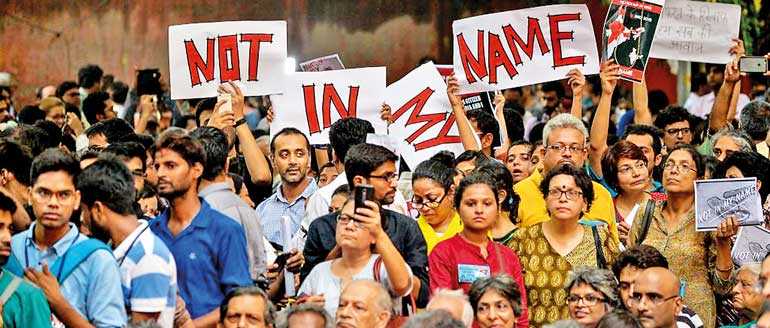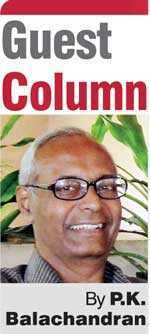Wednesday Dec 17, 2025
Wednesday Dec 17, 2025
Saturday, 27 October 2018 00:00 - - {{hitsCtrl.values.hits}}

Not in my name: Secular Indians demonstrating against the killing of Muslims by Hindutva hoodlums for eating beef or trading in cows – AFP
South Asia’s multi-religious countries, namely India, Pakistan, Bangladesh and Sri Lanka, started off with a noble wish to be ‘secular’ and keep religion out of the business of the State.
Hindu-majority India, under the leadership of the avowedly secular Jawaharlal Nehru, explicitly stated that it would be secular.
Pakistan was set up to be a “homeland” for the Muslims of the Indian subcontinent. But its founder, Mohammed Ali Jinnah, had told the last session of the All India Muslim League in December 1947, that in his view, Pakistan should be a secular state.
Jinnah said that three articles of the Pakistan constitution needed to be expunged – Article 2 (a) comprising the Objectives Resolution; Article 227, which said that no law could be repugnant to the Quran or Sunnah; and Article 203 that gave the Federal Shariat Court power to strike down any law passed by parliament that was repugnant to the Quran or the Sunnah.
Jinnah quoted Thomas Jefferson who had warned that if the church was not separated from the State, half the people would be hypocrites and the other half stupid.
“In the course of time, Muslims will cease being Muslims; Hindus will cease being Hindus, not religiously, but politically,” Jinnah said of Pakistan of his dream. (Reference: https://tribune.com.pk/story/420973/secular-pakistan-pakistanis-should-know-quaids-aug-11-speech-by-heart/)
Bangladesh had broken away from Pakistan in December 1971 on the ethnic Bengali and the Bengali language issue, and not Islam. It began as a secular State though 80% of its people were Muslims.
So did Sri Lanka, despite the fact that more than 70% of its people were Buddhists.

Regression
But it did not take long for all the three South Asian States to regress from secularism and begin to be overly influenced by the majority religious community.
Hinduism came to the political forefront in India in the early 1990s due to the Bharatiya Janata Party (BJP)-led Ram temple building movement. With the rise of the BJP, especially under the incumbent Prime Minister Narendra Modi (thanks to the growing irrelevance of the jaded secular parties like the communist and Congress parties) Hindutva is now the most potent political ideology in India.
For the first time in the history of India, its population is divided on religious lines with the majority Hindus marginalising the Muslims by not co-opting them politically and by preventing them from marrying Hindus or eating beef. Many Muslims were killed by Hindu “cow worshipers” for trading in cattle or eating beef. Secular persons are dubbed “sickular” and media persons who stand for secularism are dubbed “presstitutes”.
A fear that haunts all Indian secularists is that a heightening Hindutva ideology could foster the growth of Islamic Jihadism with its global reach and influence. So far, Jihadism has not raised its head in India, but reckless Hindutva could make sections of Indian Muslims Jehadists. And a frontal clash between the two could tear India apart with cataclysmic consequences.
Under these conditions, it is going to be a long and hard struggle for Indian secularists to put the derailed secularist ideology back on the rails.
Pakistan
Pakistan became an Islamic State officially in 1956. But it was during the military dictatorship of Gen. Zia-ul-Haq between 1977 and 1988, that the Shariah became the basis of the State. Zia established separate Shariah courts. Adultery, fornication and some types of blasphemy were added to the list of crimes. New punishments like of whipping, amputation, and stoning to death were added to Pakistani law.
Interest payments for bank accounts were replaced by “profit and loss” payments. The Islamic zakat charitable donations became a 2.5% annual tax. School textbooks and libraries were overhauled to remove un-Islamic material.
Though the enforcement of Shariah law was less after the death of Gen. Zia, Islamic parties grew with the aid of the military which had begun to use Islam as its base to secure support and loyalty.
The army-led national intelligence began to use Islamic militants to infiltrate and stir up an anti-India movement in disputed Kashmir, and to carry out terrorist attacks in other parts of India.
But secularist ideals were resurrected when civilian governments replaced the military. Under the Premiership of businessman-turned politician Nawaz Sharif, laws were passed to enhance the power of religions minorities. Human rights legislation gained currency. Mumtaz Qadri, who assassinated Salman Taseer, Punjab’s progressive Governor, was executed.
The government officially recognised Easter, Holi and Diwali, to enable the country›s beleaguered Hindu and Christian minorities to take time off from work and school to celebrate these festivals.
But the Islamist parties got activated when there was a hint that the draconian Blasphemy Law, which sanctioned death sentence for the slightest of offenses, will be amended. Even army troops could not quell demonstrations by the Islamists.
Although Islamic parties have only 10% share of the popular vote, they manage to influence government policy on key issues.
Meanwhile, Islamic terror groups like the Pakistan Taliban have been attacking army convoys and posts, posing the worst internal threat after the separatist movement in East Pakistan which resulted in the establishment of Bangladesh in 1971.
Pakistan’s new Prime Minister Imran Khan was expected to push secularism forward but he too succumbed to pressure to sack his economic advisor Dr. Atif Mian because he belongs to the Ahmadiyya community considered to be heretical by orthodox Muslims. Imran is expected to retain the draconian blasphemy law.
Bangladesh
Because the Bangladesh liberation movement was an ethnic and language-based movement, the Bangladesh was initially secular.
But when its founder-leader, Sheikh Mujib-ur-Rahman, faltered on governance issues, he began to lose public support. The vacuum was filled by Islamic forces.
Ad to placate the rising Islamic forces, Mujib began to encourage Islamic Madrassas. He also lifted court cases against Islamic activists who were being tried for collaborating with the Pakistani army during the liberation movement.
After Mujib, military dictator Gen. Zia-ur-Rahman removed the term “secular” from the preamble of the constitution. The next military dictator, Gen. H.M. Ershad, made Islam the State Religion.
The incumbent Prime Minister Sheikh Hasina restored secularism in the preamble but retained Islam as the State Religion in deference to the country’s Muslim majority.
Although in practice Bangladesh gives equal rights to the minorities and celebrates the largely Hinduistic Bengali culture, Islamic fundamentalists attack Hindus and their properties off and on with the law and order machinery looking on. School text books have obliterated Bengali Hindu writers.
Islamic fundamentalist sentiment is pandered to by all parties during election time, as 80% of the population is Muslim.
Sri Lanka
Sri Lanka was a perfectly secular State when it came into being in 1948. But by 1956, rising nationalism and political expediency had combined to trigger a radical Buddhist rival as part of the revival of Sinhalese nationalism.
Sinhalese Buddhists began to fight against dominance by the minority Tamils, both Hindu and Christian. Over time, Sinhalese nationalism, backed by the State, began to get aggressive .This led to the Tamils taking to an armed struggle which was put down ruthlessly after a 30-year war.
The 1972 republican constitution made Buddhism the “foremost religion” of Sri Lanka. Buddhism is not the State religion as such, but Buddhism is promoted by the State to the exclusion of other religions.
As a result of the special status given to Buddhism, Buddhist extremist groups and Buddhist monks are a decisive factor in Sri Lankan politics.
After subduing the Hindu Tamils by crushing the Tamil Tiger separatist rebels in 2009, Buddhist militants have turned their attention to the Muslim minority. There have been a number of attacks on mosques. There have been destructive anti-Muslim riots in Aluthgama on the West coast and Digana in the Central Province, dealing a fresh blow to the concept of secularism.